- Undergraduate
- High School
- Architecture
- American History
- Asian History
- Antique Literature
- American Literature
- Asian Literature
- Classic English Literature
- World Literature
- Creative Writing
- Linguistics
- Criminal Justice
- Legal Issues
- Anthropology
- Archaeology
- Political Science
- World Affairs
- African-American Studies
- East European Studies
- Latin-American Studies
- Native-American Studies
- West European Studies
- Family and Consumer Science
- Social Issues
- Women and Gender Studies
- Social Work
- Natural Sciences
- Pharmacology
- Earth science
- Agriculture
- Agricultural Studies
- Computer Science
- IT Management
- Mathematics
- Investments
- Engineering and Technology
- Engineering
- Aeronautics
- Medicine and Health
- Alternative Medicine
- Communications and Media
- Advertising
- Communication Strategies
- Public Relations
- Educational Theories
- Teacher's Career
- Chicago/Turabian
- Company Analysis
- Education Theories
- Shakespeare
- Canadian Studies
- Food Safety
- Relation of Global Warming and Extreme Weather Condition
- Movie Review
- Admission Essay
- Annotated Bibliography
- Application Essay
- Article Critique
- Article Review
- Article Writing
- Book Review
- Business Plan
- Business Proposal
- Capstone Project
- Cover Letter
- Creative Essay
- Dissertation
- Dissertation - Abstract
- Dissertation - Conclusion
- Dissertation - Discussion
- Dissertation - Hypothesis
- Dissertation - Introduction
- Dissertation - Literature
- Dissertation - Methodology
- Dissertation - Results
- GCSE Coursework
- Grant Proposal
- Marketing Plan
- Multiple Choice Quiz
- Personal Statement
- Power Point Presentation
- Power Point Presentation With Speaker Notes
- Questionnaire
- Reaction Paper
Research Paper
- Research Proposal
- SWOT analysis
- Thesis Paper
- Online Quiz
- Literature Review
- Movie Analysis
- Statistics problem
- Math Problem
- All papers examples
- How It Works
- Money Back Policy
- Terms of Use
- Privacy Policy
- We Are Hiring

Cell Phone Use While Driving, Essay Example
Pages: 5
Words: 1290
Hire a Writer for Custom Essay
Use 10% Off Discount: "custom10" in 1 Click 👇
You are free to use it as an inspiration or a source for your own work.
Users are increasingly using cell phones currently. The National Highway Traffic Safety Administration (NHTSA) states that around 800,000 drivers use their cell phone every day (NHTSA, 2004). Cell phones are a huge distraction to drivers, as well as others who are near the driver being distracted, due to the attention being taken away from the driver. Like changing a stereo, who would want to be distracted by averting their eyes towards their phone? Texting and the conversations that take place on the cell phone cause accidents, and these two certainly represent the main causes. Any use of cell phones should be prohibited due to the dangers it causes to the driver and drivers around the one being distracted.
The use of cell phones while driving is dangerous. Fatal accidents have and will continue to occur with cell phones. There are clearly enough distractions on the road that one must be cautious of, so to handle an automobile safely, such as other automobiles, pedestrians, animals, signage, and many others. The added weights that cell phones convey, in terms of usage and stimuli, are too much for any driver on the road. Cell phone stimuli create an unsafe environment for the driver and those around. From a January 2010 report from the National Safety Council, 28% of car crashes (1.6 million accidents) are caused by cell phone conversations and texting (III, 2010).
Cell phones can delay reaction times, especially those that are hand-held. Other cars and pedestrians become targets when one’s reflexes are undermined with the cell phone. Research demonstrates a reduction of brain activity by 37% (Nationwide, 2009). Thus, a driver’s ability to concentrate is severely undermined with regards to a cell phone conversation or other distraction posed by the cell phone. According to the NHTSA, 5,780 deaths and 515,00 personal injuries have been caused by driver distractions (III, 2010).
A conversation, albeit with a passenger or by cell phone, draws the attention of the driver away from the road to a degree. Additionally, the driver may not be able to hear surrounding sounds while driving, which is important in many cases, such as sounds from emergency vehicles. Studies have been performed on the comparisons between the danger of cell phone use and normal conversations with a passenger while driving. While there is some literature that has documented the risk of passenger conversations while driving, there are studies that demonstrate the increased danger with cell phone use in comparison. A University of Utah (Drews, 2004) simulation confirms the increased risk of cell phone conversations to passenger conversations. In these and other experiments, drivers are less distracted while talking to passengers than they are when speaking to someone on a cell phone. This literature confirms the dangerous status of cell phone use while driving, as it is evident that cell phone conversations are more dangerous than those with a passenger.
Other considerations add onto the distractions. As not all drivers use hands-free capabilities while speaking on the road, this incurs a level of danger. One less hand is not conducive for safe driving. When multitasking drivers who use a cell phone couple this use with something else, such as eating or writing down a note, driving safety is further compromised and compounded. As of March 2010, seven states have passed laws requiring hands-free devices when one uses a cell phone while driving. Banned are cell phones while driving in California, Connecticut, New Jersey, New York, Oregon, Utah and Washington, plus Washington, D.C and the Virgin Islands (GHSA, 2010). An offender may not have to incur of a traffic offense to be able to be cited for cell phone use while driving. Novice drivers are not able to use a cell phone when driving in twenty-three states. Bus drivers are not able to use the phone on a bus when passengers are present for seventeen states and the District of Columbia (GHSA, 2010).
As one might imagine, driving with the cell phone is made even more unsafe when the act of texting is considered. Texting truly undermines the safety of drivers, even more than that of normal cell phone use on the road. Twenty one states and the District of Columbia ban text messaging for all drivers. In fifteen of these states, and the District of Columbia, this is a primary enforcement. States also display bans for texting, only for drivers (GHSA, 2010). While a number of states have banned texting while driving, further measures are needed. Universal laws should be imposed with stricter consequences. As texting may become a more main stream of communication as opposed to oral conversation, texting may become more dangerous than normal cell phone usage. Knowing that cell phone usage should be prohibited while driving based on earlier stats, it becomes evident and urgent to ban texting while driving. While there is limited testing on the subject, research has demonstrated increased danger with texting while driving. An unreleased study from the University of Utah saw accidents related to texting increase six times (Livadas, 2007). Further studies have demonstrated increased risk in auto accidents from texting, even as text messaging rose in the late 2000s as attention increased. 200,000 accidents are listed by a source from drivers texting while they are driving on their cell phones (III, 2010).
Research has also demonstrated a higher risk of impairment with cell phone use while driving than alcohol use. This finding is quite shocking. Intoxicated drivers are not legally permitted to drive automobiles; any equal or higher risk to it should be very revealing. The University of Utah Psychology department studied this in 2003. The findings demonstrated, and the study concluded, that cell phone use was more impairing than driving intoxicated (Strayer, 2003). From these results, cell phone use while driving is more dangerous than drunk driving.
Cell phone use while driving is simply not safe. Cell phone usage places a number of limitations on the driver of an automobile, and it has been demonstrated in terms of reaction time, stimuli, and other factors that contribute to its inherent danger. Prohibiting cell phone use is the most important way to help make the roads a safer place. Prohibiting cell phone use will help to eliminate the current dangers posed by driving while talking on the cell phone. Furthermore, more uniform and stronger measures should be implemented against texting, which should go above and beyond the ramifications of driving while talking on a cell phone. Eliminating talking on the cell phone and texting would inevitable produce safer roads and less traffic accidents. Educating drivers about the dangers of cell phone use while driving can help lessen these dangers. There are enough dangers and distractions on the road today to allow cell phone usage to threaten safe roads.
Drews, Frank; Monisha Pasupathi and David L. Strayer (2004). “ Passenger and Cell-Phone Conversations in Simulated Driving ” (PDF). Proceedings of the Human Factors and Ergonomics Society 48th Annual Meeting.
Livadas, Greg (July 14, 2007). “ Text Messaging Not Illegal but Data Clear on Its Peril ”. http://www.democratandchronicle.com/apps/pbcs.dll/article?AID=/20070714/NEWS01/707140333&template=printart. Retrieved 2010-04-06
Strayer, David; Frank Drews and Dennis Crouch. (2003). “ Fatal Distraction? A Comparison of the Cell-Phone Driver and the Drunk Driver ” (PDF). University of Utah Department of Psychology.
GHSA, . (2010). Cell Phone and Texting Laws. Retrieved Apr. 10, 2010, from Governors Highway Safety Association, Washington, DC. Web site: http://www.ghsa.org/html/stateinfo/laws/cellphone_laws.html.
III, . (2010). Cellphones and Driving. Retrieved Apr. 10, 2010, from Insurance Information Institute, New York, NY. Web site: http://www.iii.org/media/hottopics/insurance/cellphones/.
Nationwide, . (2009). Driving While Distracted: Statistics You Need to Know. Retrieved Apr. 10,2010, from Nationwide, Columbus, OH. Web site: http://www.nationwide.com/newsroom/dwd-facts-figures.jsp.
NHTSA, . (2004). Cell Phone Use on the Roads in 2002. Retrieved Apr. 10, 2010, from National Highway Traffic Safety Administration, Washington, DC. Web site: http://www-nrd.nhtsa.dot.gov/Pubs/809580.PDF.
DOT, . (2009). Distracted Driving Summit. Retrieved Apr. 10, 2010, from Department of Transportation, Washington, DC. Web site: http://www.distraction.gov/files/take-action/summit-agenda.pdf.
Stuck with your Essay?
Get in touch with one of our experts for instant help!
Terrorism and Human Rights, Essay Example
Sociological Theory, Research Paper Example
Time is precious
don’t waste it!
Plagiarism-free guarantee
Privacy guarantee
Secure checkout
Money back guarantee

Related Essay Samples & Examples
Voting as a civic responsibility, essay example.
Pages: 1
Words: 287
Utilitarianism and Its Applications, Essay Example
Words: 356
The Age-Related Changes of the Older Person, Essay Example
Pages: 2
Words: 448
The Problems ESOL Teachers Face, Essay Example
Pages: 8
Words: 2293
Should English Be the Primary Language? Essay Example
Pages: 4
Words: 999
The Term “Social Construction of Reality”, Essay Example
Words: 371
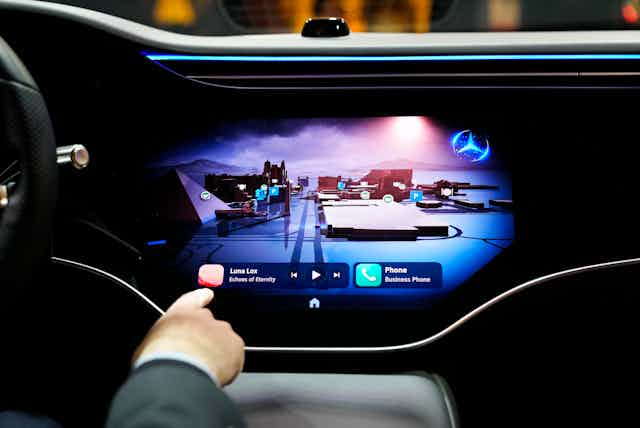
Even hands-free , phones and their apps cause dangerously distracted driving
Associate Professor of Industrial Engineering, UMass Amherst
Disclosure statement
Shannon Roberts receives funding from the Massachusetts Department of Transportation, National Science Foundation, Sloan Foundation, Toyota Collaborative Safety Research Center, and US Department of Transportation. She has received funding from GM in past years.
UMass Amherst provides funding as a founding partner of The Conversation US.
View all partners
Do you ever use your cellphone while driving? Don’t feel too guilty about saying yes – nearly 60% of drivers admit to using their phone in hands-free mode while driving.
But don’t become complacent either. Using your cellphone in hands-free mode while driving is not a perfectly safe activity, despite the impression you might be getting from laws, marketing messages and the behavior of people around you.
Fatal crashes caused by driver distraction have not gone down significantly over time: Distraction caused 14% of fatal crashes in 2017 and 13% of fatal crashes in 2021. Given that these numbers are calculated based on police-reported crashes, many experts believe the actual number of crashes caused by driver distraction is much higher. For example, real-world crash data from teens indicates that 58% of their crashes are due to driver distraction .
I am a human factors engineer who studies how drivers interact with technology . I see a gap between what people are told and what people should do when it comes to using your cellphone behind the wheel.
Hands-free calling
Most U.S. states ban hand-held cellphone use while driving but allow hands-free devices . However, hands-free devices are still distracting. Talking on a hands-free phone and driving is multitasking, and humans are not good at doing two cognitively demanding tasks at the same time.
For example, having a phone conversation in hands-free mode while driving causes you to stop looking out for hazards on the road and gets you into more close calls where you slam on the brakes than if you were not on the phone.
These detrimental effects last even after you end your call. There is a hangover effect: You can remain mentally distracted nearly 27 seconds after you finish using your cellphone . At 65 miles per hour, you’ve traveled nearly half a mile in 27 seconds.
Third-party apps
Third-party apps that connect your smartphone to your car’s interface, such ass Apple CarPlay and Android Auto, encourage you to use your phone in hands-free mode while driving. You can control things like music, navigation, text messaging and phone calls using voice commands and the car’s interface. IPhone users can connect their phones to more than 800 car models and Android phone users more than 500 models .
But is using these third-party apps while driving safe? Fifty-three percent of people say that if carmakers put the technology in vehicles, they must be safe . Though these third-party apps make cellphone use hands-free, they unintentionally cause you to look away from the road for dangerous amounts of time and they slow your reaction time .
Driving automation and distraction
Recent advances in technology have made driving a safer activity. Systems such as Cadillac Super Cruise and Tesla Autopilot control your steering and acceleration in limited situations, but they don’t mean you can text at will. Though it’s often lost in the marketing and enthusiasm for the systems, you are still required to pay attention to the road when you’re using them.
Research has shown that drivers using Level 2 automation, which combines adaptive cruise control with lane centering, are more likely to take their eyes off the road . Research also shows that watching a video or doing anything distracting while using these systems is unsafe – you stop looking at the road , and when you need to respond, it takes more time .
Some systems work to keep you focused on driving by monitoring your eye or head position to make sure you’re looking straight ahead. If your eyes are off the road for more than a few seconds, the systems alert you to bring your attention back to driving. This makes it difficult to get distracted by your phone.
Distracted driving awareness
April is Distracted Driving Awareness Month . Distracted driving – in hands-free mode, using a third-party app or when using driving automation – still claims thousands of lives each year in the U.S. Despite continual advances in vehicle technology, cellphone use while driving is likely to remain a challenging problem for the foreseeable future.
To discourage distracted driving, it’s important to look back to see what’s worked in the past to keep roads safe. Modifying the culture around distracted driving as well as comprehensive education, training and media campaigns, similar to “ Click It or Ticket ” to encourage seat belt use, are good examples of what works. To that end, on April 1, 2024, the National Highway Traffic Safety Administration launched the “ Put the Phone Away or Pay ” campaign to discourage distracted driving.
And for all of those who drive with children in the car, be sure to model safe behavior – they are watching and learning from you.
- Distracted driving
- Inattention
- Smartphone use

Project Officer, Student Volunteer Program

Audience Development Coordinator (fixed-term maternity cover)

Lecturer (Hindi-Urdu)

Director, Defence and Security

Opportunities with the new CIEHF
- Writing services
- Proofreading
- Math/Science
- Copywriting
- Dissertation services
- Admission services
- Our Writers
Persuasive Essay about Mobile Phones and Driving

Table of contents:
- Introduction and hook/thesis
So, you’ve chosen to write about the use of mobile or cell phones while driving as a persuasive essay. This isn’t as straightforward question as it might appear. While pretty much everyone would agree that mobile or cell phones should never be used as you drive, the situation is a bit more complicated than the demand to just ban cell phones while driving. One of the biggest problems of this case is texting while driving (don't text and drive!) Consider, for instance, the use of hands-free kits as a compromise – are they just as much of a distraction?
Start off your introduction with a hook that grabs your audience’s attention, then dive into your thesis, or statement of purpose, which should set out the ultimate point you are attempting to persuade people of. See the samples below for some ideas on how to write these.
Introduction examples
Hook & Thesis: Driving while using a mobile or cell phone could lose you up to 3 or 4 demerit points, plus make you subject to a costly fine, and that’s not even counting the danger you’re putting yourself into while doing it. If you must use a phone while driving, you should always use a hands-free kit, or better yet, just concentrate on driving, and save yourself the distraction and risk.
Hook & Thesis: Alarmingly, over 42 percent of smartphone users decide that it’s okay to use their phones while driving, according to research by Deloitte in 2015. This dangerous practice puts property and lives at risk for no good reason.
As you carry on into the body of your essay, create an outline of your points, followed by the evidence you’ll use to back up those points. You can use any kind of evidence in persuasive essays, whether that’s anecdotes, stats, or just emotional pleading. It’s up to you. You should have at least three points of evidence in the body of your essay.
Then, as you draw toward the conclusion, make sure you briefly go over all the points you made. This is your last chance to remind your audience of what you are trying to persuade them to do.
End with a call to action, encouraging your readers to take some sort of action based on your persuasiveness, or at least to think about the topic differently from now on. Have a look at the examples below to see some ideas for how to conclude a topic on driving with mobile or cell phones.
Conclusion examples
Conclusion: As we’ve seen, driving while talking on the phone can be very dangerous. Also, if you’re caught, you can be fined and receive demerit points, which could ultimately get your driver’s license suspended. Avoid all this trouble by only talking on your mobile phone when you are parked out of the way of traffic. It could save your life one day.
Conclusion: The use of a hands-free kit with your mobile phone as you drive doesn’t eliminate risk, as you still might be distracted, but it does help cut it down. Driving a car is dangerous enough without adding still more risk by texting or talking while you drive, so get yourself a hands-free kit today!
- Essay samples
- Infographics
- Essay writing
- Crafting a Powerful Essay on Political Polarization
- Oral Health Overview Essay: Preventing Tooth Decay in Australia
- How to Write a Good Expository Essay About Macbeth
- How to Write An Expository Essay About Love
- How to Write a Great Expository Essay About Life
Price per page
Total price:
Limitless Amendments
Bibliography
Plagiarism Report
Get all these features for A$93.12 FREE
If you don't know exactly what type of paper you need or can't find the necessary one on the website - don't worry! Contact us and we'll help you out!
- Terms of Use
- Money Back Guarantee
- Cookie Policy
- Privacy Policy
- Write My Essay
- Custom Essay
- Essay Writer
- Do My Essay
- Type My Essay
- Pay For Essay
- Cheap Essay
- Write My Paper
- Write My Assignment
- Assignment Writer
- Buy Assignment
- Assignment Help
- Do My Assignment
- Nursing Essay Writing Service
- Management Essay
- Business Essay
- Law Essay Writing Service
- Education Essay Service
- Marketing Essay
- Accounting Essay
- Sociology Essay
Before continuing to use our service please make sure you got acquainted with our Cookie Policy and accepted it by clicking OK
An Analysis of the Use of Cell Phones While Driving Essay
Introduction, the theory of mass society, cell phone and texting while driving, the theory of culture industry, cell phone texting while driving.
Popular culture encapsulates the society’s wholesome activities. Popular culture is the expression of a society’s common beliefs, practices, rituals and ideas through various expressions and materials identifiable with a given society (Browne, 2005, p.3). The cell phone is one of the most prevalent communication devices across the globe today.
Nearly all teens and adults in America own at least one cell phone. When used while driving, the cell phone poses a grave danger to the driver and other road users. Unfortunately, the dangerous habit of texting while driving is extremely common on American roads and highways. There are two theories on popular culture that apply to the act and practice of texting while driving. The first theory is the theory of mass society, and the second theory is the theory of the culture industry.
The theory of mass society states that, popular culture is an intrinsic expression of the demands and aspirations of the people of a society. The cell phone itself is a cultural icon. In the American society, and especially amongst teens and the youths, cell phone is not only a communication device, but also an entertainment source and a status symbol.
With its widespread use, the cell phone has been the subject of many popular myths that have no logical of scientific foundation. For instance, the widely held myth that radiation from cell phones affects the sperm quality of men persists with little empirical and scientific evidence to support it.
The act of texting while driving is an expression of the status of modern society. As many Americans acquire cell phones and cars, the phenomena of texting while driving, however dangerous, is bound to occur. The average American engages in multiple tasks; therefore, the use of phones to send a quick message while driving is an expression of the contemporary American’s ever-busy schedule and almost ceaseless engagements.
The theory of the culture industry states that popular culture is an expression of the schism of class within a society. According to this theory, popular culture is an expression of the beliefs, values, practices, and images (icons) of people of lower classes within a society. Within the context of the theory of culture, popular culture is almost equitable to an act of rebellion towards the higher class and authority.
In the US, youths are most notorious for using their cell phones while driving. The act of texting while driving is perpetuated by the popular myth that the youths, especially women, can easily multitask. This myth highlights the almost superhuman abilities of a woman in performing various engaging tasks simultaneously.
Although various campaigns and advertisements by government agencies seek to highlight the dangers of texting and the general use of the cell phone while driving, the dangerous habit continues to persist amongst the youths. Some states like California have even enacted laws against the use of cell phone while driving. As the culture industry theory states, the persistence of this dangerous practice, especially amongst the youths, can be attributed to a rebellion against the authority.
The application of these two theories on popular culture, in the analysis of the popular culture of cell phone texting while driving, enabled an in-depth understanding of the practice/culture. The theory of mass society aided me in gaining insight on the culture of cell phone texting as an emergent expression of the youth of society.
On the other hand, the theory of the culture industry helped me to point to practice as a form of rebellious expression. Therefore, an analysis of the topic through the provisions of these two theories enabled for a much broader and in-depth understanding of the topic.
Browne, R. B. (Ed.). (2005). Profiles of Popular Culture: A Reader . Madison, Wisconsin: University of Wisconsin Press.
- Chicago (A-D)
- Chicago (N-B)
IvyPanda. (2020, January 28). An Analysis of the Use of Cell Phones While Driving. https://ivypanda.com/essays/an-analysis-of-the-use-of-cell-phones-while-driving/
"An Analysis of the Use of Cell Phones While Driving." IvyPanda , 28 Jan. 2020, ivypanda.com/essays/an-analysis-of-the-use-of-cell-phones-while-driving/.
IvyPanda . (2020) 'An Analysis of the Use of Cell Phones While Driving'. 28 January.
IvyPanda . 2020. "An Analysis of the Use of Cell Phones While Driving." January 28, 2020. https://ivypanda.com/essays/an-analysis-of-the-use-of-cell-phones-while-driving/.
1. IvyPanda . "An Analysis of the Use of Cell Phones While Driving." January 28, 2020. https://ivypanda.com/essays/an-analysis-of-the-use-of-cell-phones-while-driving/.
Bibliography
IvyPanda . "An Analysis of the Use of Cell Phones While Driving." January 28, 2020. https://ivypanda.com/essays/an-analysis-of-the-use-of-cell-phones-while-driving/.
- Dangers of Texting while Driving
- Banning Texting while Driving Saves Lives
- The South Dakota Legislature on Texting and Driving
- Texting While Driving Should Be Illegal
- A Theoretical Analysis of the Act of Cell Phone Texting While Driving
- Drunk Driving vs. Texting While Driving
- Texting's Importance for the Society
- Texting as a Valuable Way of Communication
- Tougher Punishment for Texting While Driving
- Saving Lives: On the Ban of Texting While Driving
- Marriage and Family Imagery in the Cinematography
- What Are the Elements of Persuasion
- Home With No Father: Single Mothers
- How to Have a Happy Marriage
- Knowledge and the Loss of Innocence: "A Good Man Is Hard to Find"
Home — Essay Samples — Law, Crime & Punishment — Cell Phones and Driving — Should Cellphones Be Banned While Driving
Should Cellphones Be Banned While Driving
- Categories: Cell Phones and Driving Distracted Driving
About this sample

Words: 1035 |
Published: Sep 12, 2023
Words: 1035 | Pages: 2 | 6 min read
Table of contents
Introduction, the dangers of distracted driving, arguments for banning cellphones while driving, arguments against banning cellphones while driving, the case for stricter regulations, 1. road safety, 2. reduced distraction, 3. equal enforcement, 1. personal responsibility, 2. enforcement challenges, 3. technological solutions.

Cite this Essay
Let us write you an essay from scratch
- 450+ experts on 30 subjects ready to help
- Custom essay delivered in as few as 3 hours
Get high-quality help

Verified writer
- Expert in: Law, Crime & Punishment

+ 120 experts online
By clicking “Check Writers’ Offers”, you agree to our terms of service and privacy policy . We’ll occasionally send you promo and account related email
No need to pay just yet!

Related Essays
5 pages / 2098 words
6 pages / 2847 words
4 pages / 1863 words
4 pages / 1788 words
Remember! This is just a sample.
You can get your custom paper by one of our expert writers.
121 writers online
Still can’t find what you need?
Browse our vast selection of original essay samples, each expertly formatted and styled
Related Essays on Cell Phones and Driving
Distracted driving has become a significant concern in today's fast-paced world, with one of the most prevalent distractions being texting while driving. Despite the well-documented dangers, many individuals continue to engage [...]
Texting and driving and drinking and driving are two dangerous behaviors that pose significant risks to road safety. In this essay, we will explore the similarities and differences between these behaviors, the consequences they [...]
Cell phones have become an integral part of our lives, and it is difficult to imagine a life without them. However, research has shown that continuous use of cell phones can be unsafe, particularly when it comes to using them [...]
Texting and driving refer to the practice of sending or reading text messages while operating a vehicle. This dangerous behavior has become increasingly prevalent, especially among young drivers, and has been shown to have [...]
Texting and driving has become a pressing issue that poses serious risks to drivers, passengers, and pedestrians alike. This persuasive essay aims to highlight the dangers of texting and driving, urging individuals to recognize [...]
Mankiewicz’s All About Eve uses the theatre as a medium in which the female protagonists, Eve and Margo, are victimized at the hands of varying internal and external factors. The film clearly portrays Margo as a casualty of [...]
Related Topics
By clicking “Send”, you agree to our Terms of service and Privacy statement . We will occasionally send you account related emails.
Where do you want us to send this sample?
By clicking “Continue”, you agree to our terms of service and privacy policy.
Be careful. This essay is not unique
This essay was donated by a student and is likely to have been used and submitted before
Download this Sample
Free samples may contain mistakes and not unique parts
Sorry, we could not paraphrase this essay. Our professional writers can rewrite it and get you a unique paper.
Please check your inbox.
We can write you a custom essay that will follow your exact instructions and meet the deadlines. Let's fix your grades together!
Get Your Personalized Essay in 3 Hours or Less!
We use cookies to personalyze your web-site experience. By continuing we’ll assume you board with our cookie policy .
- Instructions Followed To The Letter
- Deadlines Met At Every Stage
- Unique And Plagiarism Free
Distracted Driving
- Types of Distraction
- How big is the problem?
- Who is most at risk for distracted driving?
- How to Prevent Distracted Driving
- What States are Doing to Prevent Distracted Driving
- What the Federal Government is Doing to Prevent Distracted Driving
- Distracted Driving Fact Sheet
- Additional Resources
Nine people in the United States are killed every day in crashes that are reported to involve a distracted driver . 1
Distracted driving is doing another activity that takes the driver’s attention away from driving. Distracted driving can increase the chance of a motor vehicle crash.
Anything that takes your attention away from driving can be a distraction. Sending a text message, talking on a cell phone, using a navigation system, and eating while driving are a few examples of distracted driving. Any of these distractions can endanger you, your passengers, and others on the road.
There are three main types of distraction: 2
- Visual: taking your eyes off the road
- Manual: taking your hands off the wheel
- Cognitive: taking your mind off driving
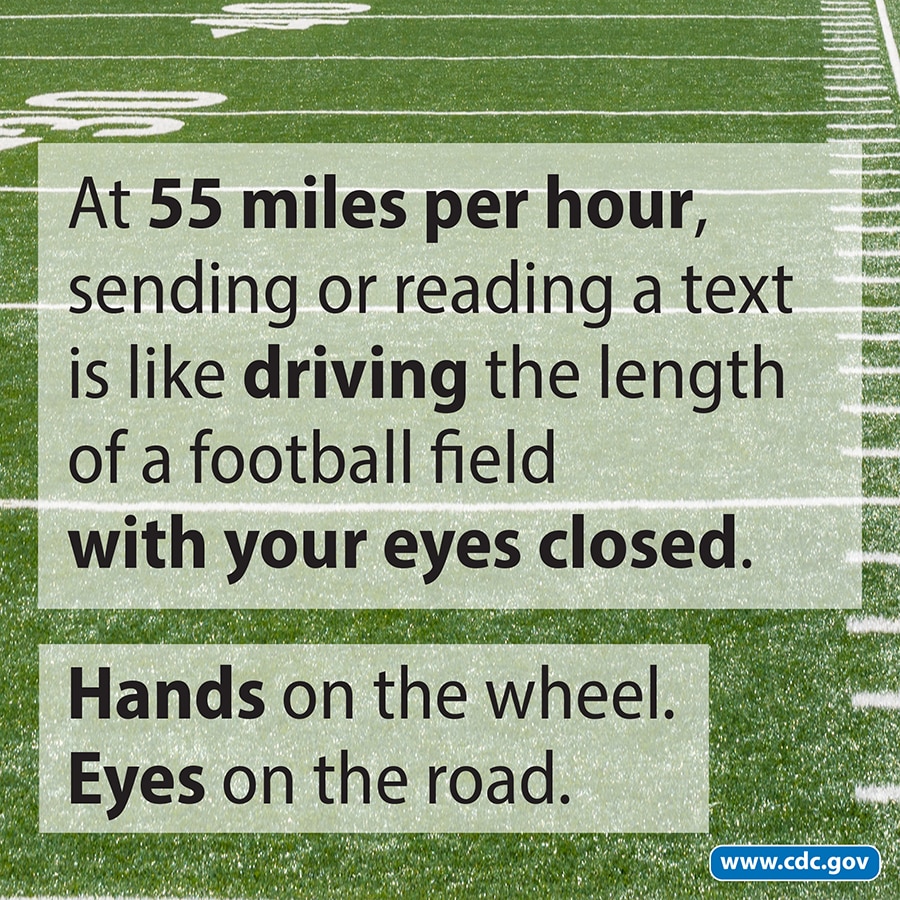
- In the United States, over 3,100 people were killed and about 424,000 were injured in crashes involving a distracted driver in 2019. 1
- About 1 in 5 of the people who died in crashes involving a distracted driver in 2019 were not in vehicles―they were walking, riding their bikes, or otherwise outside a vehicle. 1
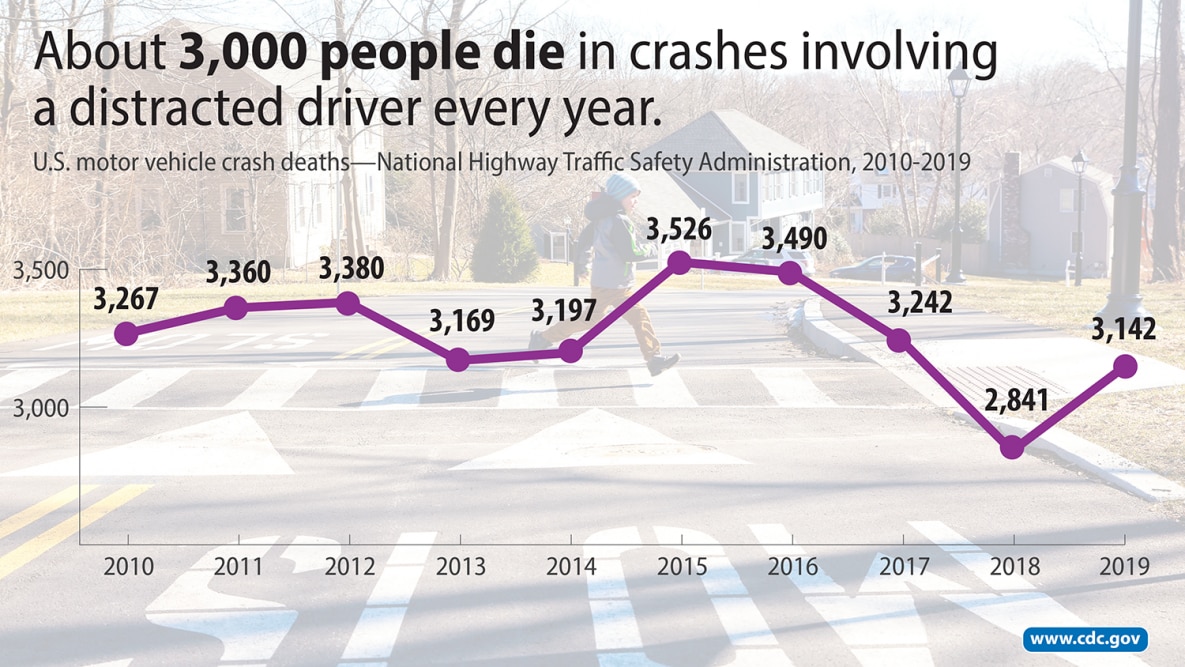
Sources: National Highway Traffic Safety Administration, 2010-2013 , 2014–2018 and 2019
You can visit the National Highway Traffic Safety Administration (NHTSA) website for more information on how data on motor vehicle crash deaths are collected and the limitations of distracted driving data.
Young adult and teen drivers
- A higher percentage of drivers ages 15–20 were distracted than drivers age 21 and older.
- 39% of high school students who drove in the past 30 days texted or emailed while driving on at least one of those days. 4
- Texting or emailing while driving was more common among older students than younger students (see figure below) and more common among White students (44%) than Black (30%) or Hispanic students (35%). 4
- Texting or emailing while driving was as common among students whose grades were mostly As or Bs as among students with mostly Cs, Ds, or Fs. 4
- more likely to not always wear a seat belt;
- more likely to ride with a driver who had been drinking alcohol; and
- more likely to drive after drinking alcohol. 4
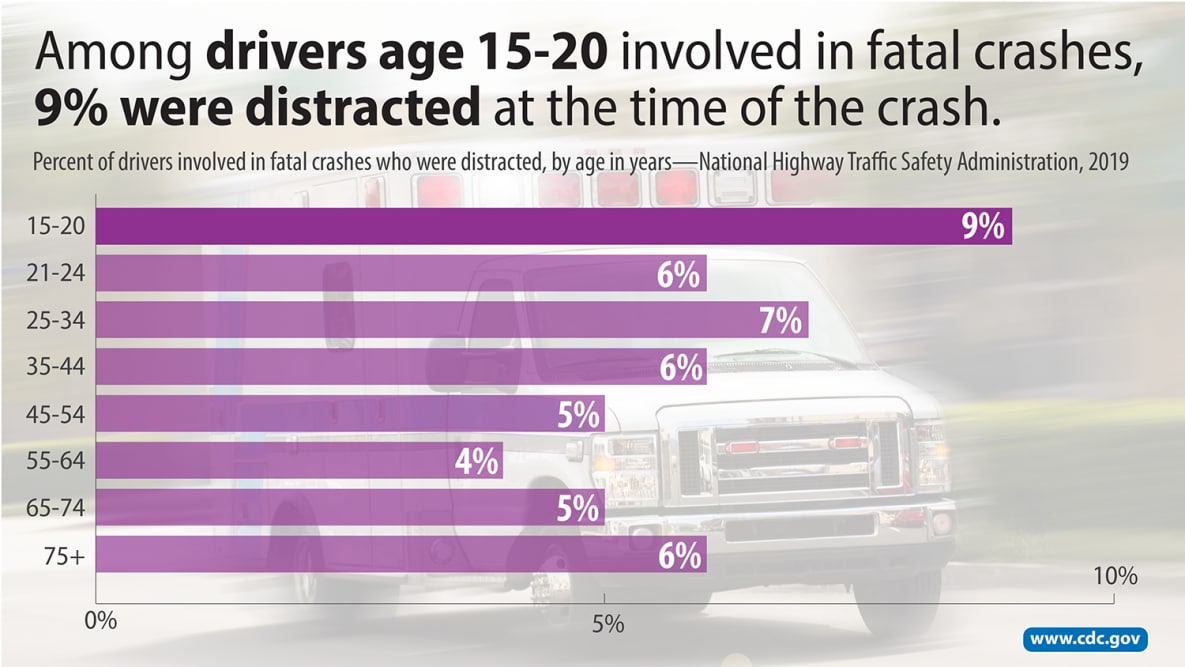
Source: National Highway Traffic Safety Administration , 2019
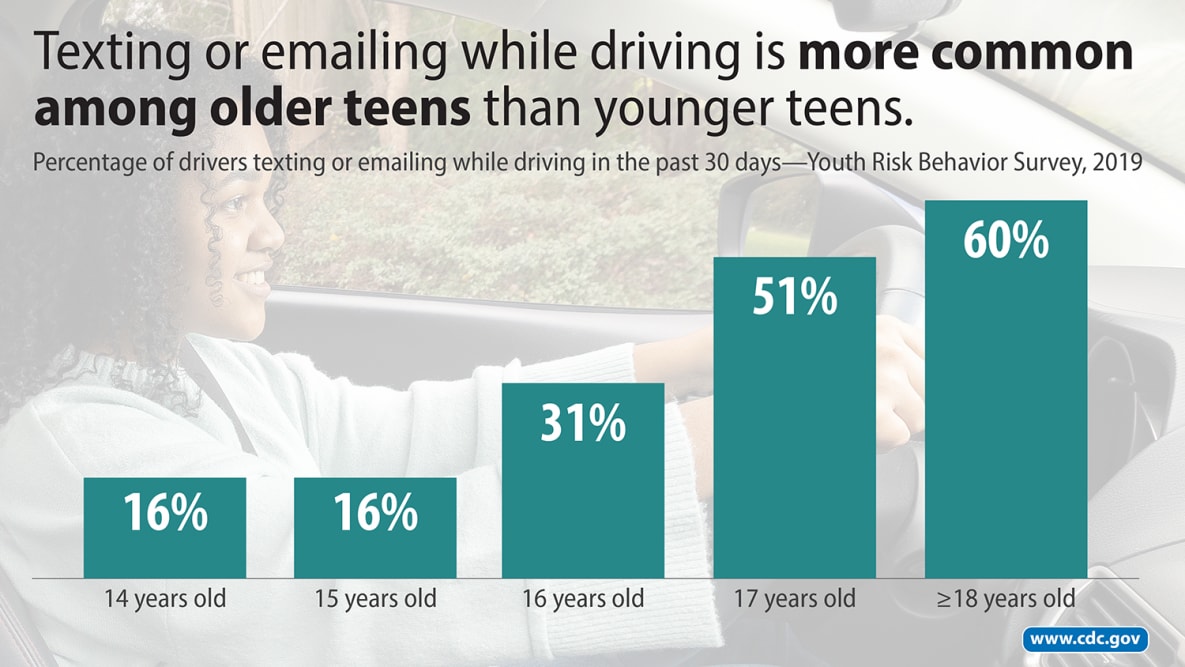
Source : Transportation Risk Behaviors Among High School Students — Youth Risk Behavior Survey, United States, 2019
What drivers can do
- Do not multitask while driving. Whether it’s adjusting your mirrors, selecting music, eating, making a phone call, or reading a text or email―do it before or after your trip, not during.
- You can use apps to help you avoid cell phone use while driving. Consider trying an app to reduce distractions while driving.
What passengers can do
- Speak up if you are a passenger in a car with a distracted driver. Ask the driver to focus on driving.
- Reduce distractions for the driver by assisting with navigation or other tasks.
What parents can do 5
- Remind them driving is a skill that requires the driver’s full attention.
- Emphasize that texts and phone calls can wait until arriving at a destination.
- Familiarize yourself with your state’s graduated driver licensing system and enforce its guidelines for your teen.
- Know your state’s laws on distracted driving . Many states have novice driver provisions in their distracted driving laws. Talk with your teen about the consequences of distracted driving and make yourself and your teen aware of your state’s penalties for talking or texting while driving.
- Set consequences for distracted driving. Fill out CDC’s Parent-Teen Driving Agreement [PDF – 465 KB] together to begin a safe driving discussion and set your family’s rules of the road. Your family’s rules of the road can be stricter than your state’s law. You can also use these simple and effective ways to get involved with your teen’s driving: Parents Are the Key.
- Set an example by keeping your eyes on the road and your hands on the wheel while driving.
- Learn more: visit NHTSA’s website on safe teen driving .
- The Insurance Institute for Highway Safety tracks cell phone use laws and young passenger restrictions by state.
- 4.1% to 2.7% in the Sacramento Valley Region in California, 6
- 6.8% to 2.9% in Hartford, Connecticut, 7
- 4.5% to 3.0% in the state of Delaware, 6 and
- 3.7% to 2.5% in Syracuse, New York. 7
- Graduated driver licensing (GDL) is a system which helps new drivers gain experience under low-risk conditions by granting driving privileges in stages. Comprehensive GDL systems include five components 8- 9 , one of which addresses distracted driving: the young passenger restriction. 10 CDC’s GDL Planning Guide [PDF – 3 MB] can assist states in assessing, developing, and implementing actionable plans to strengthen their GDL systems.
- Some states have installed rumble strips on highways to alert drowsy, distracted, or otherwise inattentive drivers that they are about to go off the road. These rumble strips are effective at reducing certain types of crashes. 10
- CDC has developed the Parents Are the Key campaign, which helps parents, pediatricians, and communities help keep teen drivers safe on the road.
- In 2022, the U.S. Department of Transportation released the National Roadway Safety Strategy [PDF – 42 pages] . Part of the strategy includes supporting vehicle technology systems that detect distracted driving.
- In 2021, Congress provided resources to add distracted driving awareness as part of driver’s license exams as part of the Bipartisan Infrastructure Law [PDF – 1039 pages] .
- In 2009, President Obama issued an Executive Order prohibiting federal employees from texting while driving government-owned vehicles or when driving privately owned vehicles on official government business.
- In 2010, the Federal Railroad Administration banned cell phone and electronic device use for railroad operating employees on the job.
- In 2010, the Federal Motor Carrier Safety Administration banned commercial vehicle drivers from texting while driving.
- In 2011, the Federal Motor Carrier Safety Administration and the Pipeline and Hazardous Materials Safety Administration banned all hand-held cell phone use by commercial drivers and drivers carrying hazardous materials.
- NHTSA has several campaigns to raise awareness of the dangers of distracted driving, including their annual “U Drive. U Text. U Pay.” campaign, which began in April 2014.
- NHTSA has issued voluntary guidelines to promote safety by discouraging the introduction of both original, in-vehicle [PDF – 177 pages] and portable/aftermarket [PDF – 96 pages] electronic devices in vehicles.
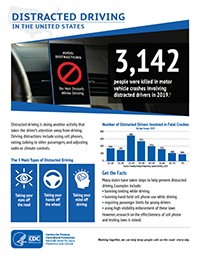
This fact sheet provides an overview of distracted driving and promising strategies that are being used to address distracted driving.
Distracted Driving Summary Fact Sheet [PDF – 660 KB]
- CDC MMWR – Transportation Risk Behaviors Among High School Students — Youth Risk Behavior Survey, United States, 2019
- CDC MMWR – Mobile Device Use While Driving — United States and Seven European Countries, 2011
- NHTSA – Distracted Driving
- Governors Highway Safety Association – Distracted Driving
- Insurance Institute for Highway Safety – Distracted Driving
- World Health Organization – Mobile Phone Use: A Growing Problem of Driver Distraction
- National Institute for Occupational Safety and Health (NIOSH) – Distracted Driving at Work
- National Highway Traffic Safety Administration (NHTSA) – Campaign Materials
- National Highway Traffic Safety Administration. (2021). Traffic Safety Facts Research Note: Distracted Driving 2019 (DOT HS 813 111) . Department of Transportation, Washington, DC: NHTSA. Accessed 8 February 2022.
- National Highway Traffic Safety Administration. (2010). Overview of the National Highway Traffic Safety Administration’s Driver Distraction Program (DOT HS 811 299) [PDF – 36 pages] . U.S. Department of Transportation, Washington, DC. Accessed 8 February 2022.
- Centers for Disease Control and Prevention. Youth Risk Behavior Surveillance System . Accessed 8 February 2022.
- Yellman, M.A., Bryan, L., Sauber-Schatz, E.K., Brener, N. (2020). Transportation Risk Behaviors Among High School Students — Youth Risk Behavior Survey, United States, 2019 . MMWR Suppl, 69(Suppl-1),77–83.
- National Highway Traffic Safety Administration. Teen Driving . Accessed 8 February 2022.
- Chaudhary, N.K., Connolly, J., Tison, J., Solomon, M., & Elliott, K. (2015). National Highway Traffic Safety Administration. Evaluation of the NHTSA Distracted Driving High-Visibility Enforcement Demonstration Projects in California and Delaware [PDF – 72 pages] (DOT HS 812 108) . U.S. Department of Transportation, Washington, DC.
- Chaudhary, N.K., Casanova-Powell, T.D., Cosgrove, L., Reagan, I., & Williams, A. (2012). National Highway Traffic Safety Administration. Evaluation of NHTSA Distracted Driving Demonstration Projects in Connecticut and New York [PDF – 80 pages] (DOT HS 811 635) . U.S. Department of Transportation, Washington, DC.
- Centers for Disease Control and Prevention. (2019). Motor Vehicle Injuries . Accessed 8 February 2022.
- Venkatraman, V., Richard, C. M., Magee, K., & Johnson, K. (2021). Countermeasures that work: A highway safety countermeasures guide for State Highway Safety Offices, 10 th edition, 2020 (Report No. DOT HS 813 097) [PDF – 641 pages] . U.S. Department of Transportation, Washington, DC.
- Federal Highway Administration. (2011). Technical Advisory: Shoulder and Edge Line Rumble Strips (T 5040.39, Revision 1) [PDF – 9 pages] . Department of Transportation, Washington, DC: FHWA. Accessed 24 August 2020.
To receive email updates about this topic, enter your email address:
Exit Notification / Disclaimer Policy
- The Centers for Disease Control and Prevention (CDC) cannot attest to the accuracy of a non-federal website.
- Linking to a non-federal website does not constitute an endorsement by CDC or any of its employees of the sponsors or the information and products presented on the website.
- You will be subject to the destination website's privacy policy when you follow the link.
- CDC is not responsible for Section 508 compliance (accessibility) on other federal or private website.
- Authentic custom writing service
- Confidential and secure
- Only custom written work
- Essay on using cell phones while driving
Argument Essay on the Use of Cell Phones while Driving
Cell phones were introduced in the United States market in the decade of 1980 and their usage instantly grew during next two decades. The trend of using cell phones has increased throughout the world. One of the primary reasons for the gigantic growth of cell phones is that they facilitate communication offering high levels of flexibility reaching desired person within seconds whether he/she is at office, home, or outside driving a car etc. Cell phones support in making a direct contact with person effectively and without wastage of any time. Other main reason for the explosive growth of cell phones is the safety aspect. Cell phones make it easy to contact during emergency even during driving although using cell phone while driving is mostly dangerous and not advisable, it provides the convenience of tackling emergency situation, listening music through hands-free, and tracking routes etc. In this context the thesis of the paper is presented as follows:
Thesis statement : it is hypothesized that despite an effective way of communication, using cell phones during driving results in distracting attention of driver increasing road safety concerns.
Undesired Situation by Using Cell phones during Driving
Billions of people throughout the world are using cell phones in daily routine life. Cell phones provide communication with greater flexibility. It is, nowadays considered less fashion and more a utility providing several benefits. Cell phones have different features in addition to communication including cameras, video games, music, FM receivers etc. Cell phones not only facilitate business and personal convenience they also provide comfort and safety. However, observations, experience, and studies all have highlighted the dangerous effects of using cell phones during driving, strictly unadvisable, and an illegal matter. The major drawback of using cell phones during driving is that it distracts attention of driver. (Scotti, 2007)
There are number of traditional ways that distracts driver's attention. They include talking to passengers, lighting and smoking a cigarette, eating, drinking etc. It is pertinent to mention that attention of driver distracted through cell phones means driving and communicating at the same time that increases threats to safety. Furthermore, drivers has also to operate both, vehicle and cell phone, simultaneously, that also distract attention leading to dangerous accidents, and in some cases resulting in death of driver and passengers. In other words, cell phones reduce driver's performance. (Gravelle, 2005)
Despite offering huge benefits, cell phones have become a grave concern and a major cause of road accidents. Drivers using cell phones are not able to give their complete attention on roads exposing not only themselves but also other people on the road. Therefore, most of the governments, including Austria, Australia, Switzerland, Greece, Germany, and different Asian as well as African countries, have imposed restriction on using cell phones during driving.
Because of diversion in attention drivers reacts slowly to the traffic signals, missing them at times. Decision making during driving is a critical factor giving drivers fraction of a second to make a swift decision about a given complex scenario. Studies have highlighted those drivers using cell phones react slowly and often make wrong decision causing serious accidents involving other vehicles also. (Gravelle, 2005)
Drivers demonstrates comparatively slower braking responses and also had low awareness of other traffic flowing through the roads ignoring their presence concentrating more on cell phones and less on roads as how other drivers are behaving. Different studies have reported hundreds of deaths during a year because of using cell phones during driving.
Increased Chances of Fatal Accidents
Several researchers have proved that using cell phones during driving makes driver more exposed to fatal accidents. Focus of the driver is not on the road or traffic and it becomes difficult to handle phone and vehicle at one time. Cell phones during driving also reduce the mental capacity of drivers as they fail to concentrate on minor or major activities happening around them. As already discussed, cell phones distract drivers' attention resulting in comparatively slow response to traffic signals and other related traffic events. Studies have shown the fact that breaking reaction time is also slower while talking on a cell phone during driving. The perception, vision, general awareness, and concentration of the driver are impacted while communicating on a cell phone during driving. Especially during bad weather or driving on slippery roads, drivers engage in conversation pay less attention to these areas increasing risks of fatal accidents. (Gravelle, 2005)
The main advantage to avoid using cell phone during driving is ensuring safety of driver, vehicle, and other people driving on the road. By making conversation, writing messages, or just playing with the mobile increases the chances of accidents. It is pertinent to highlight that hands-free phones have also similar negative impacts during driving; both distracts attention, although hands-free cell phones do not require manual handling. (Sturnguist, 2006)
The nature of conversation on cell phones during driving differs and can have distinctive impacts on drivers. The complexity of conversation draws more attention of drivers, while simple or casual conversation is less distracting, however, both may produce same consequences. As such, the more complex a situation is higher are chances of distraction that presents a threat to road safety. (Klein, 2000)
Cell phone users while driving has low level of perceptions. There exists a direct relationship between perception and performance of a driver. Distracted attention results in low perception of the driver reducing performance levels. A major strength of driving skills is a pro-active approach anticipating actions of other drivers and making adjustments accordingly. However, a driver busy in conversation on a cell phone is unable to adopt a pro-active approach and it becomes almost impossible to anticipate other person's attitude as well as behavior. The consciousness of events happening around vehicle has a huge impact on driving. It is necessary for the drivers to monitor outside events and their possible impacts on driving. Using cell phones make it difficult to keep an eye on the outside events. Negligent behavior is highly immoral and unethical as it exposes human lives to a huge threat of accidents that could ultimately lead even to death. (Gravelle, 2005)
Some Benefits of Cell Phones during Driving
Although, there are grave negative impacts of using cell phones during driving it is pertinent, for the sake of arguments, to present benefits also. The most important benefit of cell phones during driving is again the security factor. During emergency situations cell phones can provide help and driver can make emergency calls, even reporting any dangerous scenario such as roadside accidents. Through cell phones a driver can locate the desired route. Furthermore, using FMs on cell phones can provide information about weather and traffic. (Sturnguist, 2006)
The paper has presented arguments on both sides of the issue using or not using cell phones during driving. On the basis of arguments presented in the paper, it can be concluded that despite an effective way of communication, using cell phones during driving distracts attention of driver increasing road safety concerns.
Gravelle, K (2005) The Driving Book: Everything New Drivers Need to Know but Don't Know to Ask, Walker Books for young Readers
Klein, N (2000) Drive Without Fear: The Insecure Driver's Guide to Independence, 1st Books Library
Scotti, A (2007) Professional Driving Techniques: The Essential Guide to Operating a Motor Vehicle with Confidence and Skill, PhotoGraphics Publishing
Sturnguist, D (2006) Mobile Phones and Driving, Nova Science Publishers

- Entertainment
- Environment
- Information Science and Technology
- Social Issues
Home Essay Samples Sociology Cell Phones and Driving
Cell Phone Use Can Be Dangerous: Cell Phone Use While Driving
Works cited.
*minimum deadline
Cite this Essay
To export a reference to this article please select a referencing style below

- Race and Gender
- Intercultural Communication
- Human Development Index
Related Essays
Need writing help?
You can always rely on us no matter what type of paper you need
*No hidden charges
100% Unique Essays
Absolutely Confidential
Money Back Guarantee
By clicking “Send Essay”, you agree to our Terms of service and Privacy statement. We will occasionally send you account related emails
You can also get a UNIQUE essay on this or any other topic
Thank you! We’ll contact you as soon as possible.
- NURBURGRING WEBCAMS
- WORK FOR US

2025 Toyota 4Runner Gets New Trailhunter Overland Trim – And Everything Else We Know

Lamborghini Creates Special Revuelto For Raging Bulls Gathering At Imola

New Chery iCar V23 Looks Like The Electric Defender That Land Rover Won’t Make (Yet)
Editor's picks.

Dodge Hornet Outsells Alfa Tonale 10:1, Stellantis Sees 10% Drop In Q1 Sales
Smart Traffic Signs Spot Phone Usage, Tell You To Put It Down
Pilot programs are underway for "smart signs" that use infrared and microwave technology to detect distracted driving and speeding

by Sebastien Bell
- Smart signs can tell if a driver is speeding, not wearing a seatbelt, or using their phone and will remind them to drive safely.
- Technology is being piloted in locations across the country, including Seattle and Washington, D.C.
- The signs cannot collect personal data and don’t issue tickets, but act as a reminder to stay focused.
Portable signs that show drivers a digital readout of their speed and tell them to slow down if they’re speeding are a common site on the road today. In some places, those signs will now tell distracted drivers to put their phones down, too.
“Smart signs” that use infrared and microwave technology are being trialed in different locations across the country , such as Seattle, Washington, and Washington, D.C. Cities say these devices can tell if a driver is speeding, not wearing a seatbelt, or driving distracted.
Read: US Traffic Deaths Still Too High Despite 2023 Decline
Like the above-mentioned digital speed readouts, the smart signs can’t actually punish drivers. However, NPR reports that they can warn the driver that they’re committing a faux pas, and tell them to “put your phone down,” in the hopes of discouraging the bad behavior. On the other hand, people who are driving well are greeted by a smiley face.
Tim Hogan, the CEO of SaferStreet Solutions, which makes the signs, said that the technology can reduce distracted driving by up to 40 percent when it’s left in a single location for a month. Any improvement in driver focus is a positive.
According to a recent report from Cambridge Mobile Telematics, which tracks driver behavior for insurers, there has been an alarming rise in phone use behind the wheel in the U.S. since the start of the pandemic.
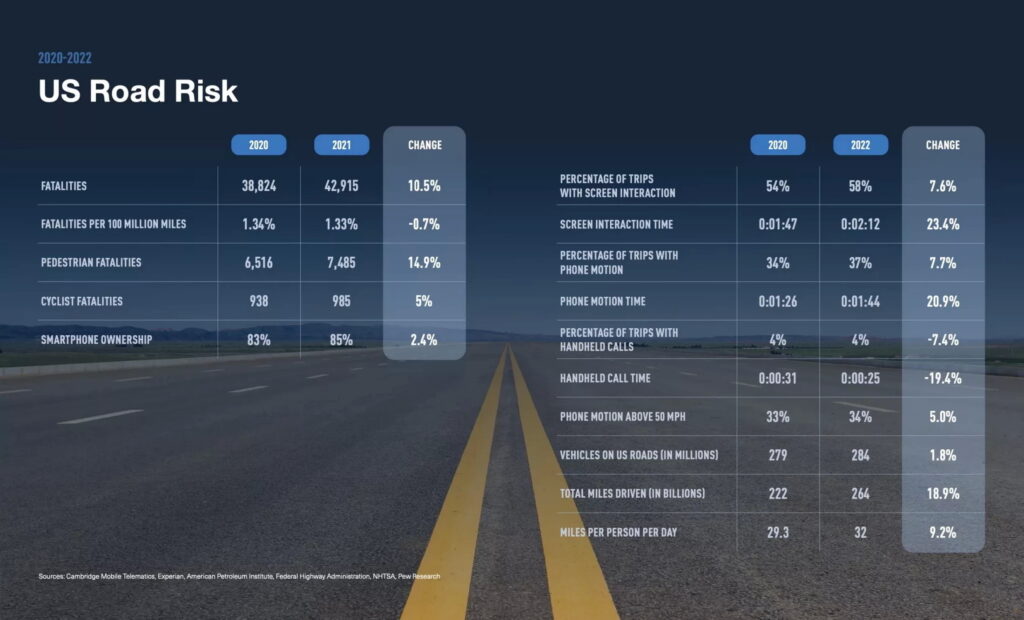
“By almost every metric CMT measures, distracted driving is more present than ever on US roadways,” the company wrote in a recent report. “Drivers are spending more time using their phones while driving and doing it on more trips. Drivers interacted with their phones on nearly 58 percent of trips in 2022.”
At the same time, the danger on America’s roads rose sharply during the pandemic, and the high level of fatalities has been described as a national crisis. Although deaths fell slightly in 2023, they are still significantly higher than they were before the pandemic, and last year more than 40,000 people died on America’s roads.
Community organizers, such as the Washington Traffic Safety Coalition, hope that these signs —which do not use cameras and cannot collect personal data — will act as a reminder to drive safely. As a result, it has started a pilot program using four smart signs that will rotate around 12 locations, including Seattle, Algona, King County, and more for eight weeks at a time.
Lead image: Fox13/YouTube

Are your eclipse glasses safe? How to tell before the total solar eclipse.
T he 2024 total solar eclipse is almost here — and if you're hoping to get a glimpse of the phenomenon, it's best to make sure that you have real, working eclipse glasses that can protect your eyes.
Here's what to know about eclipse glasses and how to check that they are safe to use.
Are solar eclipse glasses safe to view the total solar eclipse with?
Solar eclipse glasses can be used to safely view a total solar eclipse , but it's important to make sure they're of the right quality. Don't use sunglasses, smoked glass, an unfiltered telescope and magnifiers or polarized filters as a way to view the eclipse.
The only glasses that should be used to look at a partially eclipsed sun is with eclipse glasses that meet an international standard, ISO 12312-2, according to the American Optometric Association.
That international safety standard, which is set by the International Organization for Standardization , means the glasses reduce visible sunlight to a safe level, and block ultraviolet and infrared radiation, according to the American Astronomical Society website. According to the ISO, the safety standard is reviewed every five years.
Blocking that radiation is important. Ultraviolet, or UV, radiation can damage the cells of the eyes, while the infrared, or IR, radiation can generate heat that causes thermal damage, according to the National Eye Institute .
How to make sure the eclipse glasses you bought are real
Real eclipse glasses will have a note about the international standard somewhere on their body, according to the American Astronomical Society. Before buying, make sure the glasses are advertised as meeting this standard.
If you already bought the glasses, check the arm for the the "ISO 12312-2" label. The standard may also be written as "ISO 12312-2:2015," the AAS says on its website. Either designation means that the glasses will block light and radiation.
The label may be on the flat or curved part of the arm.
NASA has also released guidance on how to test your eclipse glasses. The space agency recommends putting on your glasses and finding a bright light. If the light appears extremely dim, or doesn't appear at all, when you look at it through the glasses, they are legitimate. You should only be able to see the filament of the bulb, not its glow.
How to avoid buying fake solar eclipse glasses
Checking for the international standard isn't foolproof: It's possible for sellers with products who do not meet the standard to label their eyewear with it anyway. To avoid this, make sure you're ordering glasses from a reliable source.
The American Astronomical Society advises against ordering from Amazon, Temu or other online marketplaces, and recommends against ordering if prices seem to be too good to be true. The AAS also said it's best to purchase from manufacturers based in the United States. CBS News previously reported that counterfeit glasses have been sold by companies based overseas.
The organization maintains a list of reputable vendors of solar eclipse glasses. CBS News previously reported that NASA supports the American Astronomical Society 's work, though the space agency does not maintain its own list of vendors.
The ISO, the body that established the international standard for eclipse glasses, also sells them on its website.
Why it's important to double-check older solar eclipse glasses
If you're reusing glasses from a previous solar eclipse, it's important to double-check that they are still in good condition. NASA warns against using glasses that have any marks or scratches on them. This damage can diminish the protection they offer. Glasses that have punctured lenses should also not be used.
Glasses that are more than three years old should not be used to view the 2024 total solar eclipse, according to the National Eye Institute — so if you saved your glasses from the 2017 eclipse, you may want to think about finding a new pair.
How to make sure your homemade eclipse viewing tool is safe
If you're not buying glasses, it is possible to make an indirect viewing method for viewing the eclipse at home. An indirect viewing method means that you don't look directly at the sun so your eyes remain protected even without eyewear.
NASA recommends making a pinhole projector, which uses a small opening like a hole punched in an index card, to project an image of the sun onto a nearby surface. When using a pinhole projector, keep the sun at your back and view the projected image to safely see the eclipse. However, to do this safely, it's important to make sure to avoid actually looking at the sun itself.
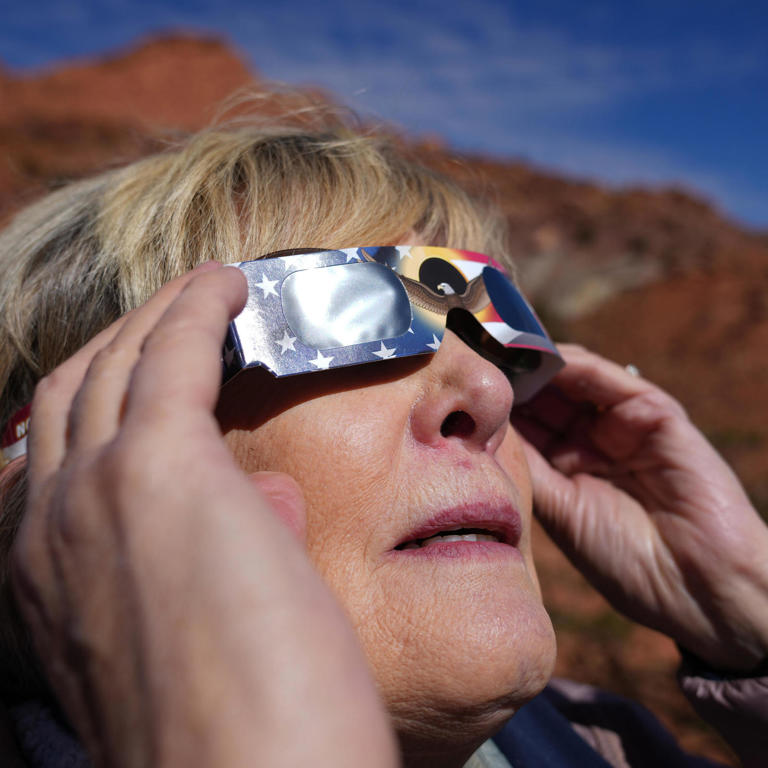

IMAGES
VIDEO
COMMENTS
Distracted driving is much worse than drunk driving. According to a study by Hosking and Michael (2009), that used both drunk drivers and drivers using cell phones for comparisons provided that driving while using cell phones is more dangerous than drunk driving. The drunk drivers utilized in the study purposefully were for comparing their ...
As of March 2010, seven states have passed laws requiring hands-free devices when one uses a cell phone while driving. Banned are cell phones while driving in California, Connecticut, New Jersey, New York, Oregon, Utah and Washington, plus Washington, D.C and the Virgin Islands (GHSA, 2010). An offender may not have to incur of a traffic ...
Using Mobile Phones While Driving is Risky Essay. Mobile phone use in motor vehicles has increased at a remarkable rate over the past 15 years. Yet it is undeniable that utilizing a cell phone while driving can affect driver performance as it relates to the overall safe operation of a vehicle.
For example, having a phone conversation in hands-free mode while driving causes you to and gets you into than if you were not on the phone. These detrimental effects last even after you end your ...
Introduction. Cell phones have become an integral part of our lives, and it is difficult to imagine a life without them. However, research has shown that continuous use of cell phones can be unsafe, particularly when it comes to using them while driving.
None of the arguments propose to drive in parallel with phone use. There is a safe way to use a cell phone in a car, such as no text messaging or phone calls while driving. Conclusion. In conclusion, it is recommended that all drivers have a cell phone in the car to assist with emergencies, navigation, and reporting crime.
this paper, the increased risk of collision when using a cell phone while driving was found to b e between. 1.3 and 5.59 times greater than no n-users. Real-world data, although scarce, has also ...
Introduction examples. Hook & Thesis: Driving while using a mobile or cell phone could lose you up to 3 or 4 demerit points, plus make you subject to a costly fine, and that's not even counting the danger you're putting yourself into while doing it. If you must use a phone while driving, you should always use a hands-free kit, or better yet ...
The authors further note the subsequent increase in the count of persons conversing on cell phones while driving unaware of the risks they pose to themselves and their passengers. In fact, Laberge-Nadeau (5) asserts that an estimated 85% of the cell phone possessor utilizes their hand set while driving. We will write a custom essay on your ...
Within the context of the theory of culture, popular culture is almost equitable to an act of rebellion towards the higher class and authority. In the US, youths are most notorious for using their cell phones while driving. The act of texting while driving is perpetuated by the popular myth that the youths, especially women, can easily multitask.
2 pages / 1035 words. Introduction The use of cellphones while driving has become a contentious issue in recent years. As these devices have become ubiquitous in our daily lives, so too have the dangers associated with distracted driving. This essay delves into the debate surrounding whether cellphones should be...
Clark warns of " […] the rusty red Camaro [tailgating] the minivan full of kids.". Drivers who use cell phones while driving are also highly dangerous to pedestrians. A young woman killed a pedestrian on a bicycle while she was texting on her phone. She may not have intended to end that person's life, but she made the poor decision to ...
This indicates that driver performance is impaired by cell phone use and drivers generally know their driving is worse when using cell phones. Other evidence against hands free cell phone use while driving is simply that talking on hands free devices is just as bad as talking on handheld devices in relation to driver performance (Ishigami & ...
Advocates for banning cellphones while driving point to several compelling arguments in favor of stricter regulations: 1. Road Safety. The foremost argument is road safety. Proponents argue that banning cellphone use while driving reduces the risk of accidents and saves lives. With distracted driving being a leading cause of accidents ...
Additionally, in an article made by the FCC titled "The Dangers of Distracted Driving" it states that "At any given daylight moment across America, approximately 660,000 drivers are using cell phones or manipulating. electronic devices while driving, a number that has held steady since 2010."
With recent research on distracted driving due to cell phone use. Now cars are being made Bluetooth themselves to people's cellphones. In different forms as well. For example, to reduce distracted driving cars are now reading people's emails, messages, and/ or notifications for drivers.
These projects increased police enforcement of distracted driving laws and increased awareness of distracted driving using radio advertisements, news stories, and similar media. After the projects were complete, observed driver cell phone use fell from: 4.1% to 2.7% in the Sacramento Valley Region in California, 6
The main advantage to avoid using cell phone during driving is ensuring safety of driver, vehicle, and other people driving on the road. By making conversation, writing messages, or just playing with the mobile increases the chances of accidents. It is pertinent to highlight that hands-free phones have also similar negative impacts during ...
The Risk of Using Cell Phone While Driving Essay. There has been a lot of issues with cell phones, not the device itself but the people that cannot go anywhere without it. F ... 1 Page | 483 Words. Sauses and Sonsequences of Distracted Teens Driving Essay. Crash! ...
Cell phone use and driving has been a highly discussed topic in the past ten years. While cell phone use is almost unanimous, the danger of being distracted while driving has lead many states to ban the use of hand held cell phones while in the car. Passing laws that require hands free devices such as blue tooth to keep your attention on the road.
For example, having a phone conversation in hands-free mode while driving causes you to stop looking out for hazards on the road and gets you into more close calls where you slam on the brakes ...
Cell Phone Use While Driving Essay. The study was attempting to determine the thoughts and behaviors that African American freshman college students in regards to cellphone use while driving. They wanted to know how the students thought cellphones (independent variable) impact driving skills (dependent variable). ...
3,308 people died and an estimated 289,310 more were injured in crashes involving distracted drivers in 2023. Among those fatalities, 621 were pedestrians or bicyclists. Zoom in: 27 states and Washington, D.C., have laws banning drivers from using handheld cellphones while driving. Teen drivers are banned from all cellphone use in 36 states and ...
10. Smart signs can tell if a driver is speeding, not wearing a seatbelt, or using their phone and will remind them to drive safely. Technology is being piloted in locations across the country ...
A driver being on the phone while driving is one of the biggest distractions drivers today face. Lastly, cell phone use while driving should be banned because it can become dangerous for oneself as well as others on the road. Not only does cell phone use for drivers endanger other people, it endangers the life of the operator itself.
When using a pinhole projector, keep the sun at your back and view the projected image to safely see the eclipse. However, to do this safely, it's important to make sure to avoid actually looking ...
Argument Essay on the Use of Cell Phones while Driving. Cell phones were introduced in the United States market in the decade of 1980 and their usage instantly grew during next two decades. The trend of using cell phones has increased throughout the world. One of the primary reasons for the gigantic growth of cell phones is that they facilitate ...